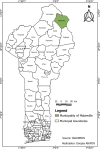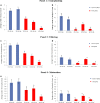Minimal tillage and intermittent flooding farming systems show a potential reduction in the proliferation of Anopheles mosquito larvae in a rice field in Malanville, Northern Benin
- PMID: 32928223
- PMCID: PMC7491134
- DOI: 10.1186/s12936-020-03406-2
Minimal tillage and intermittent flooding farming systems show a potential reduction in the proliferation of Anopheles mosquito larvae in a rice field in Malanville, Northern Benin
Abstract
Background: Irrigation systems have been identified as one of the factors promoting malaria disease around agricultural farms in sub-Saharan Africa. However, if improved water management strategy is adopted during rice cultivation, it may help to reduce malaria cases among human population living around rice fields. This study aimed to assess the impact of the different irrigation practices on malaria transmission, as well as to evaluate the water management system that will best mitigate malaria transmission in Malanville, Benin.
Methods: Knowledge, Attitude and Practice (KAP) study was conducted on 104 households staying on and around the rice fields in Malanville. The study focused on the frequency of mosquito bites and preventive measures against malaria as well as soil preparation and rice planting methods. Mosquito larvae density was assessed in different water management system: continuous flooding (CF) or intermittent flooding (IF), deep tillage (DT) or minimal tillage (MT) and normal levelling (NL) or abnormal levelling (AL) in an experimental hut set-up. Larvae were collected using dipping methods and their density was determined.
Results: Three tillage systems, which include the use of tiller, plow and hoe, were identified on the rice field. Continuous flooding was the only irrigation system used by farmers. Retrospective data from Malanville Health Centre revealed higher malaria cases during rice production season, which was also confirmed by field participants. The density of Anopheles larvae was reduced by 80.8%, 30.8% and 40.7% (P = 0.000) during transplanting, tillering and maturation periods, respectively with intermittent flooding compared to continuous flooding. In addition, a clear reduction of larva density was observed with both intermittent flooding systems applied to minimal tillage (MT + IF + NL) and intermittent flooding applied to deep tillage (DT + IF + AL), showing that intermittent flooding could reduce the abundance of malaria vector in rice fields.
Conclusion: Recommending intermittent flooding technology for rice cultivation may not only be useful for water management but could also be an intentional strategy to control mosquitoes vector-borne diseases around rice farms.
Keywords: Anopheles larvae; Continuous flooding; Deep tillage; Intermittent flooding; Malanville; Malaria; Minimal tillage; Rice field.
Conflict of interest statement
The authors declare that they have no competing interests.
Figures



Similar articles
-
["Farmer Field School", a participatory educational approach for improving the fight against malaria vectors in irrigated rice-growing areas in Benin].Med Trop Sante Int. 2023 Sep 24;3(3):mtsi.v3i3.2023.281. doi: 10.48327/mtsi.v3i3.2023.281. eCollection 2023 Sep 30. Med Trop Sante Int. 2023. PMID: 38094479 Free PMC article. French.
-
Monitoring individual rice field flooding dynamics over a large scale to improve mosquito surveillance and control.Malar J. 2025 Apr 1;24(1):107. doi: 10.1186/s12936-025-05344-3. Malar J. 2025. PMID: 40170026 Free PMC article.
-
Identification and characterization of immature Anopheles and culicines (Diptera: Culicidae) at three sites of varying malaria transmission intensities in Uganda.Malar J. 2020 Jun 23;19(1):221. doi: 10.1186/s12936-020-03304-7. Malar J. 2020. PMID: 32576188 Free PMC article.
-
The control of malaria vectors in rice fields: a systematic review and meta-analysis.Sci Rep. 2022 Nov 16;12(1):19694. doi: 10.1038/s41598-022-24055-2. Sci Rep. 2022. PMID: 36385495 Free PMC article.
-
The potential of intermittent irrigation for increasing rice yields, lowering water consumption, reducing methane emissions, and controlling malaria in African rice fields.J Am Mosq Control Assoc. 2002 Dec;18(4):329-40. J Am Mosq Control Assoc. 2002. PMID: 12542191 Review.
Cited by
-
Towards an intelligent malaria outbreak warning model based intelligent malaria outbreak warning in the northern part of Benin, West Africa.BMC Public Health. 2024 Feb 13;24(1):450. doi: 10.1186/s12889-024-17847-w. BMC Public Health. 2024. PMID: 38347490 Free PMC article.
-
Changing food systems and infectious disease risks in low-income and middle-income countries.Lancet Planet Health. 2022 Sep;6(9):e760-e768. doi: 10.1016/S2542-5196(22)00116-4. Lancet Planet Health. 2022. PMID: 36087606 Free PMC article. Review.
-
Investigating the Impact of Irrigation on Malaria Vector Larval Habitats and Transmission Using a Hydrology-Based Model.Geohealth. 2023 Dec 10;7(12):e2023GH000868. doi: 10.1029/2023GH000868. eCollection 2023 Dec. Geohealth. 2023. PMID: 38089068 Free PMC article.
-
An impact assessment of insecticides application on the non-targeted mosquito Aedes albopictus (Skuse) in Punjab rice fields, Pakistan.PeerJ. 2022 Jul 11;10:e13697. doi: 10.7717/peerj.13697. eCollection 2022. PeerJ. 2022. PMID: 35846891 Free PMC article.
-
["Farmer Field School", a participatory educational approach for improving the fight against malaria vectors in irrigated rice-growing areas in Benin].Med Trop Sante Int. 2023 Sep 24;3(3):mtsi.v3i3.2023.281. doi: 10.48327/mtsi.v3i3.2023.281. eCollection 2023 Sep 30. Med Trop Sante Int. 2023. PMID: 38094479 Free PMC article. French.
References
-
- Programme National Malaria Control. Rapport annuel d’activité. Benin: Cotonou; 2012.
-
- WHO . World Malaria report. Geneva: World Health Organization; 2018.
-
- Goonasekere KGA, Amerasinghe FP. Planning, design and operation of irrigation schemes—their impact on mosquito-borne diseases. Vectorborne disease control in humans through rice agroecosystem management. Proceedings Workshop on Research and Training Needs in the field of integrated vector borne diseases control in Rice Agroecosystem of developing countries, 9–14, 1987 International Rice Research Institute, The Philippines 1988. pp. 41–50.
-
- Antonio-Nkondjio C, Atangana J, Ndo C, Awono-Ambene P, Fondjo E, Fontenille D, et al. Malaria transmission and rice cultivation in Lagdo, northern Cameroon. Trans R Soc Trop Med Hyg. 2008;102:352–359. - PubMed
-
- Dossou-yovo J, OuattaraItai A, Doannio J, Diarrassouba S, Chauvancy G. Enquêtes paludométriques en zone de savane humide de Côte d’Ivoire. Med Trop (Mars). 1998;58:51–56. - PubMed
MeSH terms
Grants and funding
LinkOut - more resources
Full Text Sources
Medical
Miscellaneous

